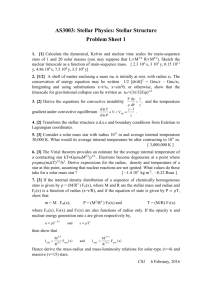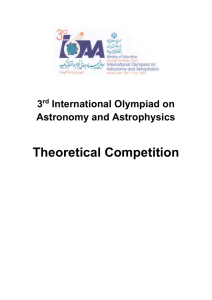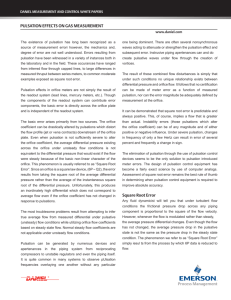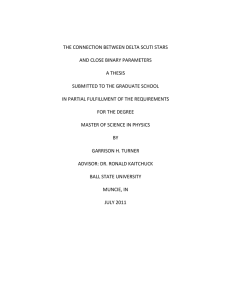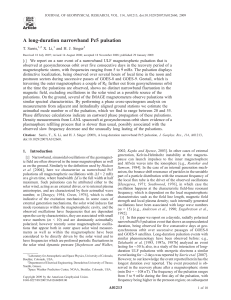hwk10
advertisement
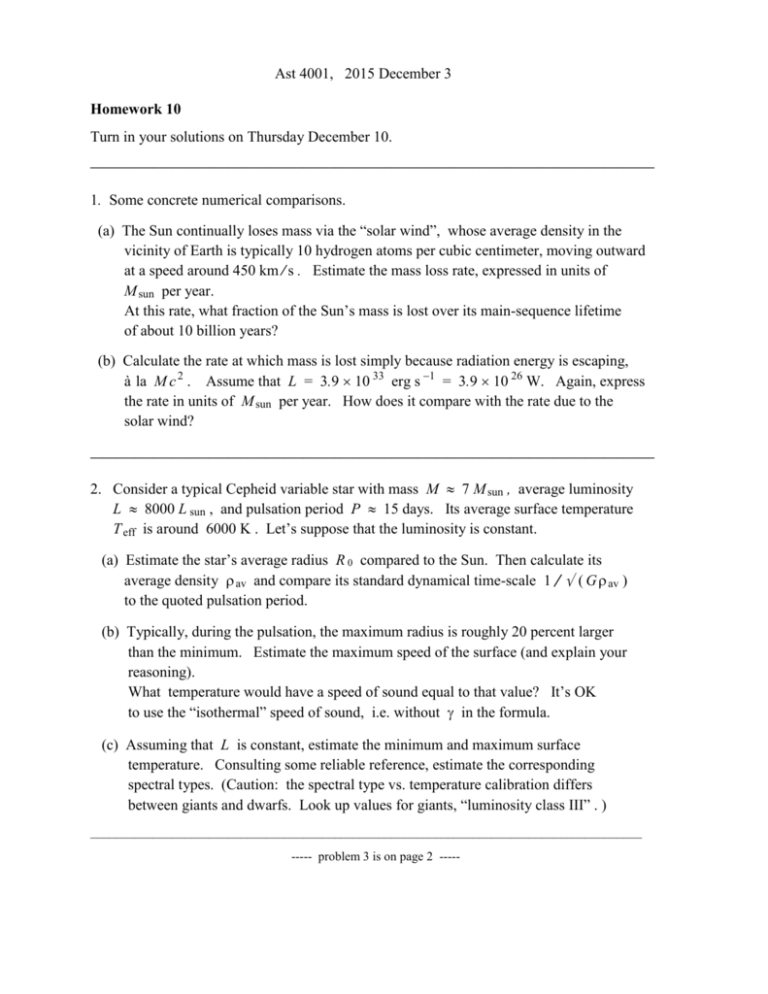
Ast 4001, 2015 December 3 Homework 10 Turn in your solutions on Thursday December 10. __________________________________________________________________________________________ 1. Some concrete numerical comparisons. (a) The Sun continually loses mass via the “solar wind”, whose average density in the vicinity of Earth is typically 10 hydrogen atoms per cubic centimeter, moving outward at a speed around 450 km / s . Estimate the mass loss rate, expressed in units of M sun per year. At this rate, what fraction of the Sun’s mass is lost over its main-sequence lifetime of about 10 billion years? (b) Calculate the rate at which mass is lost simply because radiation energy is escaping, à la M c 2 . Assume that L = 3.9 10 33 erg s 1 = 3.9 10 26 W. Again, express the rate in units of M sun per year. How does it compare with the rate due to the solar wind? __________________________________________________________________________________________ 2. Consider a typical Cepheid variable star with mass M 7 M sun , average luminosity L 8000 L sun , and pulsation period P 15 days. Its average surface temperature T eff is around 6000 K . Let’s suppose that the luminosity is constant. (a) Estimate the star’s average radius R 0 compared to the Sun. Then calculate its average density av and compare its standard dynamical time-scale 1 / ( G av ) to the quoted pulsation period. (b) Typically, during the pulsation, the maximum radius is roughly 20 percent larger than the minimum. Estimate the maximum speed of the surface (and explain your reasoning). What temperature would have a speed of sound equal to that value? It’s OK to use the “isothermal” speed of sound, i.e. without in the formula. (c) Assuming that L is constant, estimate the minimum and maximum surface temperature. Consulting some reliable reference, estimate the corresponding spectral types. (Caution: the spectral type vs. temperature calibration differs between giants and dwarfs. Look up values for giants, “luminosity class III” . ) ________________________________________________________________________________________ ----- problem 3 is on page 2 ----- 4001hwk10 - p2 ________________________________________________________________________________________ 3. Stellar pulsation and stability Oscillating systems can be analyzed in terms of energy rather than force. For instance, a mass on a spring has K.E. + P.E. = m v 2 / 2 + k x 2 / 2 . If we assume simple harmonic oscillation like x = sin t , then the total energy is constant if 2 = k / m . We can apply similar reasoning to a pulsating star, except that thermal energy must be added to the potential energy; let’s call their sum “structural energy” or S.E. This quantity is a function of the stellar radius as it expands or contracts. Then of course the rule is Total energy = K.E. + P.E. + T.E. = K.E. + S.E. = constant. In order for this idea to work, S.E. must have a minimum at some equilibrium radius R 0 , analogous to the mass-on-spring’s minimum P.E. at x = 0. “Local harmonic oscillator.” Imagine a standard model for a star. At equilibrium the pulsation kinetic energy K.E. is zero, and P , , T inside the star are known functions of radial position r . The total thermal energy and gravitational potential energy are given by familiar integrals over volume inside the star, and are related by the virial theorem. The radius automatically settles at R 0. Now suppose the star is pulsating slightly, R ( t ) = ( 1 + sin t ) R 0 where is a small constant, << 1. For simplicity, let’s assume that the pulsation is homologous so the position r of each bit of matter moves with the same oscillation factor ( 1 + sin t ) . This obviously causes the density to vary. If the pulsation is rapid, then it’s adiabatic and local variations of pressure obey P . We’ll assume that is a constant. (a) Show that S.E. = C 1 · (R / R 0 ) C 2 · ( R / R 0 ) , where C 1 and C 2 are positive energy constants that depend on the internal equilibrium structure. (b) Regard S.E. as a function of R . In order for it to have a minimum, must satisfy a simple condition. What is this condition? Explain. (Hint: Consider the slope for extremely small R , and for extremely large R . Sketch S.E. vs R for various .) (c) If that minimum of S.E. occurs at R = R 0 , deduce a relation between C 1 and C 2 . Use it to eliminate C 2 in the equation. (d) After eliminating C 2 , expand S.E. as a Taylor series in the small oscillation quantity sin t . Keep terms up to quadratic, i.e., terms proportional to and 2 but discard higher orders. Be careful to avoid simple algebraic errors! (e) Use the ( sin t ) 2 terms to find a formula for the frequency. In order to represent the kinetic energy, you'll have to define a third structure-constant C 3 . (f) Suppose that = 5 / 3 . In that case, show that the relation between C 1 and C 2 , found in part (c), agrees with the virial theorem. ________________________________________________________________________________________

